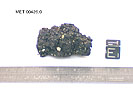
| MetSoc Home Publications Contacts |
 |
||
|
||
| Meteorite Hills 00426 | |||||||||||||||||||||
|---|---|---|---|---|---|---|---|---|---|---|---|---|---|---|---|---|---|---|---|---|---|
| Basic information | Name: Meteorite Hills 00426 This is an OFFICIAL meteorite name. Abbreviation: MET 00426 Observed fall: No Year found: 2000 Country: Antarctica [Collected by US Antarctic Search for Meteorites program (ANSMET)] Mass:  31.3 g 31.3 g | ||||||||||||||||||||
| Classification history: |
This is 1 of 185 approved meteorites classified as CR2. [show all] Search for other: Carbonaceous chondrites, Carbonaceous chondrites (type 2), and CR chondrites | ||||||||||||||||||||
Writeup |
Writeup from AMN 24(2):

Macroscopic Description: Kathleen McBride Mostly weathered fusion crust covers about 40% of the exterior surface of this meteorite. The crust resembles an overcooked brownie. The rest of the exposed surface is dark brown in color and looks like an amalgamation of melted brown chondrules. The interior of this carbonaceous chondrite is black and contains irregular shaped clasts and numerous white and rust colored chondrules 1-2 mm in size. The meteorite was easily broken and is very friable.
Thin Section (,2) Description: Tim McCoy and Linda Welzenbach
| ||||||||||||||||||||
| Data from: MB86 Table A1 Line 30: |
|
||||||||||||||||||||
| Catalogs: |
| ||||||||||||||||||||
| References: | Published in Antarctic Meteorite Newsletter 24(2) (2001), JSC, Houston Published in Meteoritical Bulletin, no. 86, MAPS 37, A157-A184 (2002)
| ||||||||||||||||||||
| Photos: |
| ||||||||||||||||||||
| Geography: |
Statistics: This is 1 of 44547 approved meteorites from Antarctica (plus 3802 unapproved names) | ||||||||||||||||||||
| Proximity search: | |||||||||||||||||||||
| Also see: |
This lists the most popular meteorites among people who looked up this meteorite.
| ||||||||||||||||||||
| Revision history: |
This lists important revisions made to data for this record.
| ||||||||||||||||||||